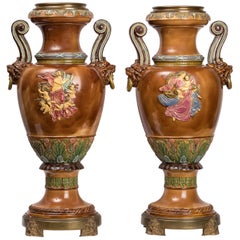R Hanke Germany
Recent Sales
Antique 19th Century German Aesthetic Movement Urns
Bronze
A Close Look at aesthetic-movement Furniture
In 1880, polymath designer William Morris declared: “If you want a golden rule that will fit everybody, this is it: Have nothing in your houses that you do not know to be useful or believe to be beautiful.” His words encapsulated the Aesthetic Movement, which prized beauty above all and blurred the lines between fine art and the decorative arts, particularly through lavishly crafted furniture pieces.
The Aesthetic Movement, whose major proponents included author Oscar Wilde, flourished from the 1860s to the 1880s and was mostly popular in England and the United States. Design expositions like the 1876 Centennial International Exhibition in Philadelphia, as well as the publishing of how-to books for interior design, helped disseminate Aesthetic Movement bedroom furniture, serveware, coffee tables and other items, especially to the middle class.
The establishment of new art museums, art clubs and a rising passion for collecting at the time contributed to a growing appreciation for art. Morris’s founding of Morris & Co. in 1862 and the commercializing of this “cult of beauty” by the Liberty store in London, starting in the late 19th century, further disseminated the idea of a domestic space that was thoughtfully and floridly designed.
Leading Aesthetic Movement furniture designers included E.W. Godwin, who drew on Japanese influences and whose work reflected a wider enthusiasm for imported East Asian art. British designer Christopher Dresser created textiles, ceramics and more that were also inspired by Japanese decorative art but were representative of additional diverse design sources that ranged from Egypt to Mexico.
The Aesthetic Movement’s eclecticism resulted in dazzling interiors. Japanese fans were positioned on Renaissance-inspired cabinets with brass hardware, while mantels made of rich walnut or finely carved ebonized wood and adorned with painted Minton tiles mingled with cast-iron chairs against a backdrop of floral wallpaper. In 1881, in New York City, stenciled checkerboard motifs and painted floral murals could be found under an opalescent glass chandelier in a luxurious dressing room designed by German émigré cabinetmaker-decorator George Alfred Schastey. Amid the rise of the industrial age, the style’s promotion of art in everyday life would inform the Arts and Crafts Movement and Art Nouveau.
Find a collection of antique Aesthetic Movement seating, tables, decorative objects and other furniture and antiques on 1stDibs.
Finding the Right urns for You
Decorative vases and antique and vintage urns are statement objects for the home that can date back centuries. Ranging from pieces with intricate, hand-painted details to more minimal forms with abstract shapes, decorative vases and urns come in a range of styles and sizes.
An urn is a type of vase that typically has a cover, a narrow neck and a round body, sometimes with a footed pedestal. However, when a vessel is called an urn, this often denotes its purpose rather than its origin or shape. One of the urn’s most crucial roles was and remains to be to hold the ashes of people for funerary rites. Another type of urn is adorned with figures that tell a story or show a scene.
Some of the earliest vases were formed from clay or metal-like bronze. Mesopotamians used them not only for decoration but also for storage. In ancient Greece, vases and urns frequently depicted stories from mythology, showing images of the gods and heroes. In ancient Egypt, vases such as the amphora had ceremonial purposes.
Over time, vases grew in popularity among artists as a different kind of canvas for expression. Unlike many of the ancient examples, these vases were not always functional but instead made for a striking addition to one’s decor. Even a plain, solid-colored vase can add color or style to a room. Metal urns are elegant additions to your living room or foyer rather than outside, unless you’re partial to the alluring weathered patina that is expected to characterize an antique cast-iron garden urn.
Every interior designer will tell you that decorative objects are what make a house a home. Decorative objects trumpet the homeowner’s personality while bringing a room to life. For designers, they present an opportunity to express their creative vision.
When looking for a decorative vase, it’s important to note the design and also the size and shape. Decorative vases vary from those with a wide base to those with long slender necks. Browse decorative vases and an extensive ceramic urn collection on 1stDibs.
